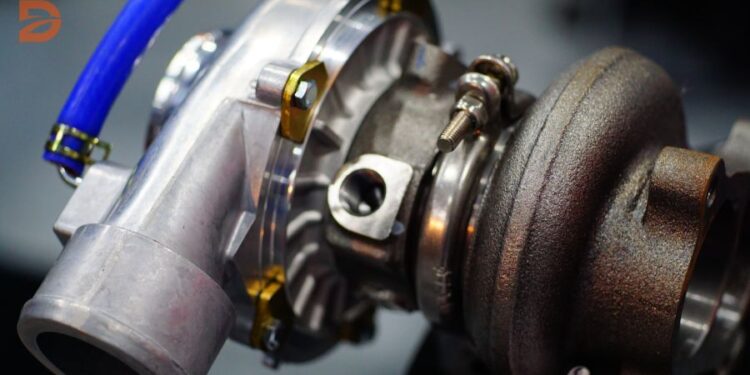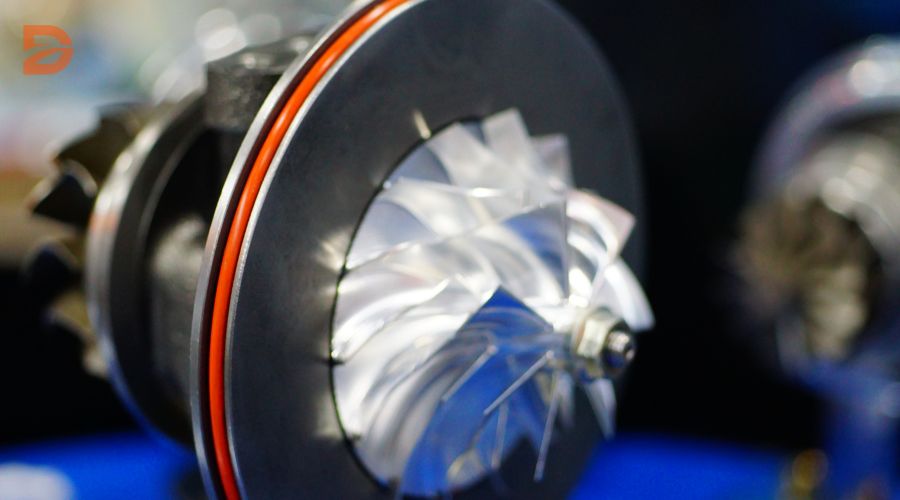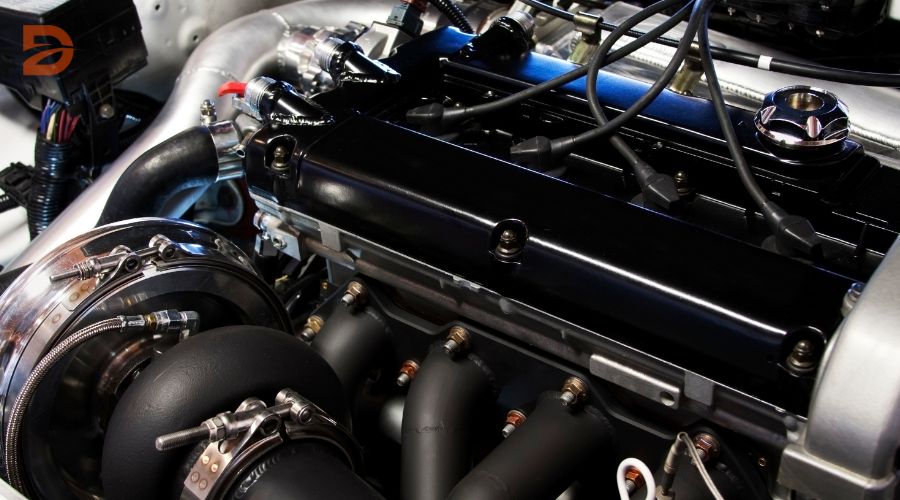In the high-octane world of automotive performance, one technology stands out as a game-changer: turbochargers. These remarkable devices have the power to transform a seemingly ordinary engine into a powerhouse, delivering a surge of speed and acceleration that can leave your driving experience forever altered. But what exactly is a turbocharger, and how can it unlock your car’s true potential?
Turbochargers are the automotive equivalent of a superpower, harnessing the energy of exhaust gases to compress the air flowing into the engine. By forcing more air into the cylinders, turbochargers allow for larger fuel injection, resulting in bigger explosions and, ultimately, more horsepower. The benefits of this forced induction system are undeniable, with the potential to boost an engine’s output by as much as 30-40% without significantly adding weight.
Key Takeaways
- Turbochargers can increase engine power and efficiency by compressing air for more fuel combustion.
- Turbo-powered engines can deliver significant horsepower gains, sometimes doubling or tripling the original output.
- Turbochargers offer benefits like improved fuel economy and reduced engine size without sacrificing performance.
- Proper tuning and maintenance are essential to harness the full potential of a turbocharged engine.
- Turbochargers come with some drawbacks, such as turbo lag and increased exhaust back pressure, which must be addressed.
What Is a Turbocharger and How Does It Work?
At the heart of a turbocharger lies the principle of forced induction. This innovative system utilizes the engine’s exhaust gases to spin a turbine, which in turn drives a compressor. The compressor forcefully pushes more air into the engine’s cylinders, enabling a greater air-fuel mixture and more powerful combustion.
More Air, More Power
By compressing the air, a turbocharger can increase the amount of air going into each cylinder by around 50%, translating to a remarkable 30-40% boost in power output compared to a naturally aspirated engine of the same size. This rapid rotation of the turbine, which can spin at up to 150,000 RPM, harnesses the energy from the engine’s hot exhaust gases to drive the compressor, resulting in a significant increase in horsepower.
Forced Induction for Increased Performance
Turbochargers are a form of forced induction, meaning they actively push more air into the engine’s cylinders, rather than relying solely on natural atmospheric pressure. This forced induction provides several benefits beyond just a power boost. Turbochargers can help engines maintain their power output at high altitudes, whereas naturally aspirated engines typically suffer from reduced performance due to thinner air. Additionally, the increased airflow and fuel efficiency provided by a turbocharger can translate to better overall engine efficiency, depending on driving conditions and the specific turbo setup.
| Statistic | Value |
|---|---|
| Air pressure at sea level | Approximately 15 p.s.i. |
| Power loss at high altitudes | Up to 25% compared to sea level |
| Turbocharger turbine speeds | Up to 150,000 rpm |
| Air compression by turbochargers | Nearly 19 pounds per square inch (30% above atmospheric pressure) |
| Power increase with turbochargers | Up to 30% more than non-turbocharged engines of the same size |
Key Components of a Turbocharger System
A turbocharger is a complex piece of machinery, with several critical components working in harmony to boost engine power. Understanding these key elements is crucial for appreciating how a turbocharger system functions and the benefits it can provide.
Turbine, Compressor, and Rotating Assembly
The heart of a turbocharger is the turbine, located on the exhaust side. This component converts the energy of the engine’s hot exhaust gases into rotational force that drives the compressor. The compressor, on the intake side, draws in and compresses the air before it enters the engine’s combustion chambers. Connecting the turbine and compressor is the center housing and rotating assembly (CHRA), which houses the shaft and bearings that allow the system to spin at extremely high speeds. Proper lubrication and cooling of these components are essential for the turbocharger’s longevity and optimal performance.
Wastegate and Actuator
Another key component of a turbocharger system is the wastegate, which is fitted on the exhaust side. The wastegate’s job is to regulate the flow of exhaust gases to the turbine, controlling the speed of the turbine and, in turn, the amount of boost pressure produced by the compressor. This is achieved through the wastegate actuator, which opens and closes the wastegate based on pressure differentials in the system. By managing the exhaust flow, the wastegate helps prevent over-boosting and excessive back pressure, which can rob power from the engine.
The Role of the Intercooler
While not technically a part of the turbocharger itself, the intercooler (or charge air cooler) is an integral component of a turbocharged system. The intercooler’s job is to cool the hot, compressed air coming from the turbocharger’s compressor before it enters the engine. This reduction in air temperature increases the air’s density, allowing the engine to draw in more oxygen-rich air for combustion, further boosting power output. The intercooler works much like a radiator, with air flowing through the internal passages while outside air is blown across the fins to dissipate the heat. This cooling process is crucial for maximizing the efficiency and performance benefits of the turbocharger.
| Turbocharger Component | Function |
|---|---|
| Turbine | Converts exhaust gas energy into rotational force to drive the compressor |
| Compressor | Draws in and compresses air before it enters the engine |
| Rotating Assembly | Connects the turbine and compressor, housing the shaft and bearings |
| Wastegate | Regulates exhaust gas flow to the turbine, controlling boost pressure |
| Intercooler | Cools the compressed air to increase its density and improve power output |
Materials and Construction of Turbochargers
Turbochargers are engineered using specialized materials that can withstand the extreme temperatures, pressures, and rotational speeds inherent in their operation. The turbine housing and wheel, which experience the highest temperatures, are typically made from high nickel-content cast iron or stainless steel alloys to resist thermal fatigue and oxidation. The compressor housing, which faces less extreme conditions, is often constructed from lighter materials like aluminum or plastic to improve overall engine efficiency.
The bearing housing, which supports the rotating assembly, is generally made from cast iron or aluminum and incorporates lubrication and cooling channels. The shafts and bearings, subjected to immense loads and speeds, are typically crafted from high-strength steel or alloyed steel. In some high-performance applications, exotic materials like Inconel superalloy may be used for their superior heat resistance.
The careful selection of materials is crucial for ensuring the turbocharger’s durability, reliability, and optimal performance. Factors such as thermal resistance and mechanical strength are key considerations in the design and manufacturing of these critical engine components.
| Turbocharger Component | Typical Materials |
|---|---|
| Turbine Housing and Wheel | High nickel-content cast iron, stainless steel alloys |
| Compressor Housing | Aluminum, plastic |
| Bearing Housing | Cast iron, aluminum |
| Shafts and Bearings | High-strength steel, alloyed steel |
| High-Performance Applications | Inconel superalloy |
The strategic use of these specialized materials in the construction of turbochargers ensures their ability to withstand extreme operating conditions and deliver reliable, high-performance power to the engine.
Naturally Aspirated vs. Turbocharged Engines
In the world of engine design, a non-turbocharged engine is referred to as a Naturally Aspirated (NA) engine. These engines rely solely on atmospheric pressure to draw in air, without the benefit of forced induction from a turbocharger. While NA engines may lack the raw power and efficiency gains of their turbocharged counterparts, they are appreciated for their linear power delivery, reliability, and the pure, unaltered sound that many enthusiasts enjoy.
On the other hand, turbocharged engines employ forced induction to dramatically increase power and efficiency. One type of turbocharger that takes this a step further is the water-cooled turbocharger. By incorporating a cooling system that uses a mixture of water and antifreeze, water-cooled turbos can better manage the excess heat generated during operation, enhancing performance and extending the turbocharger’s longevity.
The Vband Connection Advantage
Another advanced feature in turbocharger technology is the Vband connection, also known as a Vband clamp. This specialized clamping system is designed to secure the turbocharger to the exhaust system, ensuring a robust and leak-free seal. The Vband connection is engineered to withstand the high temperatures and pressures encountered in the turbo system, making it a reliable and convenient solution. Compared to traditional mounting methods, the Vband connection simplifies the installation and removal process of the turbocharger, allowing for quick and easy turbo swaps without the need for complex tools or procedures. This feature is particularly beneficial in high-performance or racing applications where rapid turbo changes may be necessary.
The Vband connection, combined with the advanced materials and construction of modern turbochargers, showcases the continuous evolution of this power-boosting technology.
Turbochargers, engine upgrades
When it comes to enhancing the performance of your vehicle, turbocharger upgrades offer a wide range of possibilities. From boosting the power of family runabouts to creating track-ready monsters, turbocharging technology provides a spectrum of options for enthusiasts and everyday drivers alike.
Externally and Internally Wastegated Turbos
The two main types of turbochargers are externally wastegated and internally wastegated. Externally wastegate turbochargers feature a separate wastegate not built into the turbo itself. This design allows for more precise control over boost pressure, making it an ideal choice for high-performance applications where fine-tuning the boost is critical. The larger size of the external wastegate also enables it to handle higher volumes of exhaust gases, potentially unlocking even more power.
On the other hand, internally wastegate turbochargers integrate the wastegate directly into the turbocharger housing. This simplified design is more compact and cost-effective, making it a suitable option for everyday driving situations that don’t require the same level of detailed boost management. While internal wastegate turbos may not offer the same level of customization, they provide a balanced blend of performance and efficiency for the average motorist.
Twin-Turbo Setups: Sequential and Parallel
For those seeking even greater power and performance, twin-turbo configurations represent the next level of turbocharging technology. A twin-turbo setup utilizes two turbochargers working in tandem to compound the benefits of forced induction. There are two main approaches to a twin-turbo setup: sequential and parallel.
- Sequential Twin Turbo Setup: In this configuration, one smaller turbocharger operates at lower engine speeds, providing a boost in low-end torque for responsive acceleration from a standstill. As engine revs increase, a larger second turbo then kicks in, maintaining the power delivery at higher rpm. This setup can be more complex and costly but offers an impressive power curve with minimal turbo lag.
- Parallel Twin Turbo Setup: Alternatively, a parallel twin-turbo setup employs two identically sized turbos, each feeding half of the engine’s cylinders. This design provides a more streamlined, balanced power delivery across the rev range.
Regardless of the twin-turbo configuration chosen, the goal is to harness the immense power-boosting potential of turbocharging technology, delivering an exhilarating driving experience.
| Turbocharger Type | Boost Control | Power Potential | Suitability |
|---|---|---|---|
| Externally Wastegated | Precise | High | High-performance applications |
| Internally Wastegated | Simplified | Balanced | Everyday driving |
| Sequential Twin Turbo | Complex | Exceptional | High-end performance |
| Parallel Twin Turbo | Streamlined | Balanced | Varied performance needs |
Conclusion
Turbochargers have emerged as a game-changing technology in the automotive world, offering a compelling solution for drivers seeking a significant boost in power and performance. By compressing the air flowing into the engine, turbochargers can increase horsepower by 30-40% without adding significant weight, making them a popular choice for both high-performance and heavy-duty applications.
The complexities of a turbocharger system, including the turbine, compressor, and wastegate, work in harmony to deliver this impressive power increase. Careful selection of materials capable of withstanding extreme temperatures and pressures is crucial for the turbocharger’s durability and longevity. As turbocharging technology continues to evolve, with advancements like water-cooling and Vband connections, the benefits of forced induction become even more compelling.
Whether it’s for enhanced acceleration, improved fuel efficiency, or the sheer thrill of unbridled power, turbochargers have the potential to transform the driving experience of any vehicle. By integrating the latest advancements in turbocharger design and materials, automakers and enthusiasts alike can unlock the true potential of their engines, delivering a level of performance that was once unimaginable.
FAQ
What is a turbocharger and how does it work?
A turbocharger is a forced induction system that uses the engine’s exhaust gases to drive a turbine, which in turn drives a compressor. This compressor forces more air into the engine’s cylinders, allowing for a greater air-fuel mixture and more powerful combustion, resulting in a significant increase in horsepower.
What are the key components of a turbocharger system?
The key components of a turbocharger system include the turbine, compressor, center housing and rotating assembly (CHRA), wastegate, and intercooler. These work together to efficiently manage the flow of air and exhaust gases to boost engine performance.
What materials are used to construct turbochargers?
Turbochargers are engineered using specialized materials that can withstand extreme temperatures, pressures, and rotational speeds, such as high nickel-content cast iron, stainless steel alloys, aluminum, and high-strength steel for the turbine housing, compressor housing, bearing housing, shafts, and bearings.
What are the differences between naturally aspirated and turbocharged engines?
Naturally aspirated engines rely solely on atmospheric pressure to draw in air, while turbocharged engines employ forced induction to dramatically increase power and efficiency. Water-cooled turbochargers and Vband connections are advanced features that enhance turbocharger performance and convenience.
What are the different types of turbocharger upgrades?
There are two main types of turbocharger upgrades: externally wastegated and internally wastegated. Externally wastegated turbos offer more precise boost control for high-performance applications, while internally wastegated turbos provide a balanced blend of performance and efficiency for everyday driving.
What is a twin-turbo setup and how does it work?
A twin-turbo setup utilizes two turbochargers working together to compound the benefits of forced induction. There are two main approaches: sequential, which uses a smaller turbo for low-end torque and a larger one for high-end power, and parallel, which employs two identically sized turbos for a more balanced power delivery.










